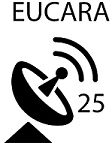Live Demonstrations – Saturday 15:00 – 17:00 & Sunday 14:30 – 16:00
E and H field Aerials for VLF — Norman Pomfret
The demonstration setup includes an 800 mm diameter E-field aerial positioned outside the conference building to minimize noise, with its signal transmitted via a screened cable to the demonstration area. A similar passive aerial will be placed inside the room for comparison. A dedicated head amplifier provides a low-impedance balanced signal to the demonstration area. Signal reception is handled by a Kiwi SDR (version 1), developed by John Seamons in New Zealand, capable of monitoring up to eight channels simultaneously with GPS timing accuracy. The SDR is powered by a passive power supply to reduce noise, and all signal cabling is balanced to minimize hum and interference. Additionally, the system includes an “Octoloop” aerial with a 100 m² effective area for VLF signal reception, mounted on a passive turntable to allow for signal alignment.
BAA-H-Line Group – Dr Andrew Thornett
The demonstration will feature a live demonstration of Hydrogen Line observing using a 13-element 1420MHz Patch Yagi antenna on a homebuilt wooden mount, showcasing data via the Easy Radio Astronomy system. A tabletop exhibit will include components and construction notes for a simple 1-meter Hydrogen-line radio telescope setup, featuring a Nooelec 1.4 GHz grid antenna on a satellite tripod, SAWBird H1 LNA, coaxial cables, RTL-SDR Blog SDR, and a MiniPC running relevant software. The display will also present analysis outputs, with a request for a poster board or funding for a larger explanatory poster. Additionally, Chinese cavity filters from WTMicrowave will be shown alongside comparison sheets illustrating their impact.
Pico muon detector — Richard Knott
The demonstration will show the new UKRAA Pico muon detector counting muon events. This new detector was inspired by the 2014 MIT detector utilising two 5 x 5 x 1cm scintillators as the detector elements. The muon events are written to data files that are date/time stamped from the internal real time clock. Data are written to a micro SD card and the serial port. This new detector comes with a suite of software for data visualisation designed to run on a Raspberry Pi4 or 5 connection via the serial port.
UKRAA multi-channel VLF receiver for Sudden Ionospheric Disturbance (SID) monitoring – Andrew Thomas
The new multi-channel SID monitoring receiver will be demonstrated displaying VLF real time data from 10 transmitters. This VLF receiver uses one of ten channels of the UKRAA Data-Hub that exploits client server technologies. The VLF data is geotagged and time stamped with muon and GeoMag data if the instruments are connected. Data is stored on internal flash RAM and a server enabling data sharing with all users. Local temperature and atmospheric pressure are also recorded.
UK Meteor Beacon — Brian Coleman
The UK meteor beacon and receiver network is a project run by volunteers from a number of different UK organisations.. The aim is to provide a meteor analysis system based on radio reflections from the ionised trail from meteors.. This is achieved by using a 50Mhz beacon transmitter and a network of linked receivers. The receivers are connected to a radio server to provide both real time and post-acquisition analysis for various radio astronomy and STEM organisations.
The SKAO’s Table-Top Radio Telescope (TTRT) — Dr Asayama, Shinichiro
Most people learn about space and the Universe through optical telescopes, either at school or as a hobby. Radio astronomy is still relatively less well known. The ICT revolution has made radio astronomy more accessible, enabling enthusiasts to build simple homemade radio telescopes using affordable, commercially available components for around £100. The SKAO’s Table-Top Radio Telescope (TTRT) is a portable, hands-on instrument capable of detecting the 21 cm radio emission from neutral hydrogen in the Milky Way.
It serves as an engaging outreach tool that demonstrates both basic and advanced physics concepts to audiences of all ages, helping to inspire and connect the next generation with radio astronomy and broader STEM (Science, Technology, Engineering, and Mathematics) fields.
Association for Astronomy Education — Alan C Pickwick. MSc, FRAS, MInstP, MBCS.
Meteor Detection using the GRAVES transmitter will be demonstrated. The GRAVES (Grand Réseau Adapté à la Veille Spatiale) system is a French radar-based space surveillance network that tracks satellite orbits using a transmitter located east of Dijon, operating at 143.050 MHz and directed southward. While the radar signal itself is not detectable in the UK due to distance, meteor ion-trails in the atmosphere can reflect the signal, allowing brief detection from the UK. This phenomenon, known for decades since the 1950s when VHF television signals were similarly reflected, can be observed today using accessible amateur equipment like a 5-element Yagi antenna, a Nooelec RTL software-defined radio, and a basic Windows 10 laptop.
